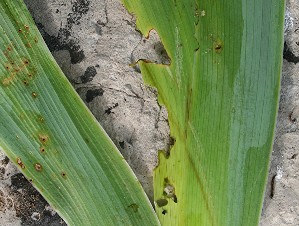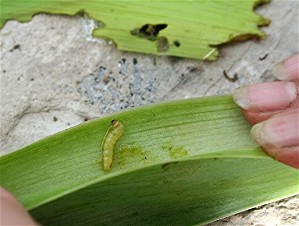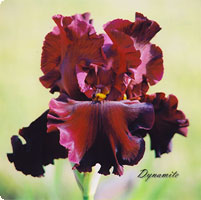Pests and Diseases
|
The "Dreaded" Iris Borer
Sometimes a nasty little caterpillar, called a borer, invades the leaves and
works its way down to the rhizome. Pests are best avoided, by being meticulous
in removing dead leaves during the growing season and particularly fall and
spring. This will help to reduce over-wintering eggs and fungus spores.
In early June, watch for disfigured leaves with notches and water streaks
where the leaves overlap as an early warning sign of borers. At this stage,
separating the leaves where they overlap and removing/squishing the little
devil will rid the plant of this problem. Most of the time there is only
one mature borer per plant.
|
 |
 |
| Leaf Damage By Borer |
There's The Little Devil |
Be sure to dig up that plant in late summer to clean up and remove a borer that may have
survived and is living in the rhizome.
Visual inspection and manual control is best. However, if
you have a significant problem, in the spring when the new
leaves are 4"-6“high, you may want to spray all your
plants with an insecticide. Check with your local garden centre
for availability and proper usage. Please note: Cygon2E is no longer available.
Some growers are using Dormant Oil spray.
To improve control, spray regularly every 2 weeks from early spring until warm weather occurs which generally stops the problem. A fungicide such as those used on Roses is helpful. Try products like "Gardal" dust or Safer's "Defender" or "3 in 1 Garden Spray".
Bacterial Soft Rot
This problem is generally caused by excessive moisture conditions, poor drainage or too much nitrogen type fertilizer. In cold, wet springs be on the look-out for symptoms which include collapsing fans and soft, mushy rhizomes.
Scrape away the soft portion with an old spoon until you reach hard, healthy rhizome tissue. Be merciless!
If the plant is sitting in a low pocket, remove any soil that is causing poor drainage around the rhizome. Dust the rhizome with powdered sulphur or powdered cleanser containing bleach. You may find it just as convenient to apply full strength household bleach onto the fresh wound. I use a water bottle to squirt the rhizome.
Keep the rhizome free from dirt and exposed to the air. Sunlight will help it heal over and the problem usually clears up in hot, sunny weather.
|


